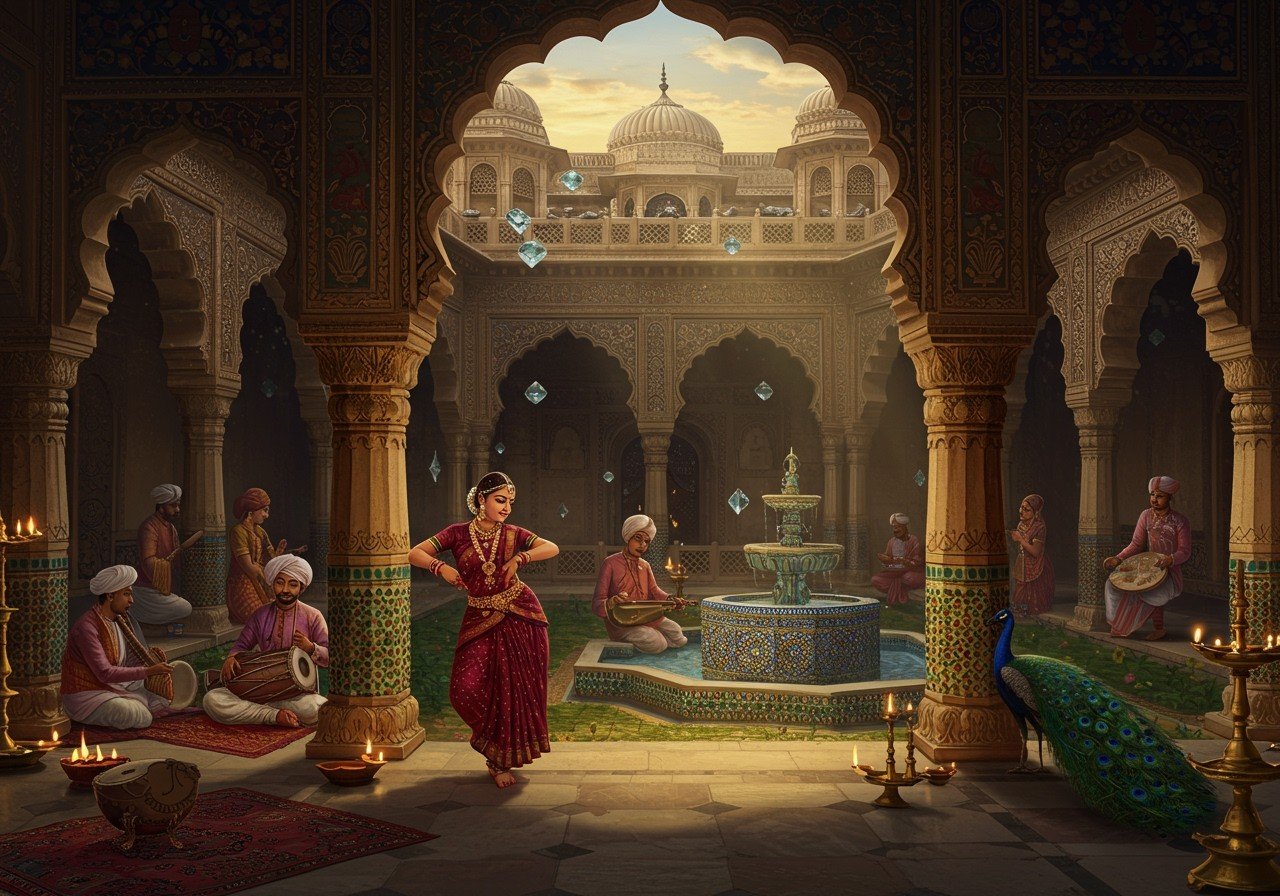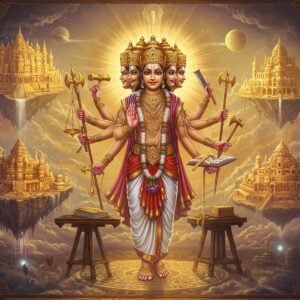
The Deccan region, nestled in the heart of India, is a treasure trove of cultural heritage. This area offers much more than the well-known Sultanates. With its unique geography, the Deccan Plateau has served as a melting pot of various cultures and traditions over centuries. From awe-inspiring temples to delectable cuisine, the Deccan’s cultural legacy is both enduring and significant.
Temples as Cultural Pillars
The Deccan is home to ancient temples that stand as architectural wonders. The rock-cut temples of Ellora and Ajanta, UNESCO World Heritage Sites, showcase intricate carvings and breathtaking paintings. These caves are not just places of worship, but also incredible feats of engineering and artistry. The Chalukyan temples in Badami, Aihole, and Pattadakal are famous for their harmonious blend of Nagara and Dravidian styles. These architectural marvels showcase the ingenuity and craftsmanship of the era. The Virupaksha Temple in Hampi, with its towering gopurams, highlights the significant contributions of the Vijayanagara Empire. These temples have served as centers of learning and community gatherings throughout history, profoundly influencing the socio-religious fabric of the region. The patronage of Deccan rulers played a crucial role in the construction and maintenance of these temples, leaving a lasting legacy for generations to come. You can learn more about the Dravidian architectural style in this insightful blog post and further explore South India’s ancient temples here.
A Tapestry of Art and Architecture
The Deccan boasts a rich tapestry of art and architecture, shaped by the hands of various dynasties. The Indo-Islamic style is exemplified by magnificent structures like the Gol Gumbaz in Bijapur, a testament to the architectural prowess of the era. Bidriware, a metal handicraft renowned for its intricate silver designs, originated in this very region. The frescoes at the Ajanta and Ellora caves vividly depict scenes from Buddhist, Hindu, and Jain mythology, showcasing the region’s rich spiritual heritage. Persian and Central Asian art significantly influenced Deccan architecture during the period of Islamic rule, adding another layer to the region’s diverse artistic landscape. The distinctive Deccan painting style, celebrated for its vibrant colors and detailed artistry, captures the essence of the region’s cultural richness. Local artisans, with their inherited skills and unwavering dedication, have played a crucial role in preserving these precious artistic traditions through generations. Their craftsmanship ensures that these art forms continue to thrive and inspire.
Flavors of Deccan Cuisine
The culinary heritage of the Deccan is as diverse and vibrant as its history. The world-famous Hyderabadi biryani, a delightful blend of Mughlai and local flavors, was introduced by the Nizams of Hyderabad, adding a royal touch to the region’s cuisine. Traditional dishes like Pesarattu, Dosa, and a variety of spicy curries reflect the rich agricultural produce of the region. The unique cooking techniques often involve the use of distinctive spices such as tamarind and coconut, giving Deccan cuisine its unique flavor profile. The region’s geography and climate play a significant role in shaping its culinary practices, influencing the ingredients and cooking methods. Historical trade routes brought exotic spices to the Deccan, further enriching its cuisine and adding to its global influences. Food plays a vital role in Deccan festivals and rituals, deeply connecting cuisine with cultural practices and creating a sense of shared heritage. For those seeking to experience the spiritual heart of Himachal Pradesh, our blog post on Himachal Pradesh temples offers a deeper understanding of the region’s sacred spaces.
A Legacy in Music and Literature
The cultural legacy of the Deccan extends beyond its tangible heritage, encompassing the realms of music and literature. It has significantly enriched Indian classical music, particularly the Carnatic tradition, adding depth and nuance to its melodic tapestry. Deccan literature, brimming with captivating poetry and timeless storytelling, continues to influence modern Indian literature, shaping its narratives and artistic expression. Languages like Kannada, Telugu, Marathi, and Urdu contribute to the region’s vibrant linguistic culture, each carrying its own unique literary traditions and expressions. Explore the rich culture of Manali beyond its temples in our blog post here.
Preserving Heritage in Modern Times
Continuous efforts are underway to preserve the Deccan’s invaluable heritage through a variety of initiatives, including vibrant festivals and engaging exhibitions. These events celebrate traditional crafts and arts, ensuring their survival and continued appreciation in the modern world. In the digital age, cultural heritage from this region is reaching global audiences through online platforms and digital archives, fostering a deeper appreciation worldwide and connecting people with the Deccan’s rich traditions. This digital outreach allows people from all corners of the globe to learn about and connect with the Deccan’s unique cultural identity.
How Poojn Helps Preserve Deccan’s Cultural Heritage
Poojn.in takes pride in offering authentic puja items that connect deeply with the Deccan region’s rich cultural practices. We understand the importance of preserving traditions and offer a curated selection to support devotees in their spiritual practices. For those interested in the traditional worship methods of the Deccan, Poojn provides:
Essential Puja Items:
- Pure copper and brass items, traditionally used in Deccan temples, are available to bring authenticity to your puja space. These items are crafted with care and reverence, reflecting the traditional craftsmanship of the region.
- Authentic kumkum and turmeric, sourced from regional sources, ensure the purity and sanctity of your rituals. We prioritize quality and authenticity, so you can perform your puja with complete peace of mind.
- Traditional cotton wicks for temple-style diyas, crafted from pure cotton, enhance the traditional feel of your puja. These wicks are made with respect for traditional methods, ensuring a clean and bright flame.
- Handcrafted puja thalis with Deccan motifs add a touch of regional artistry to your worship space. These thalis are beautifully designed and crafted with intricate details, elevating the spiritual experience.
Regional Specialties:
- Specific items used in Maharashtra’s Ganesh Chaturthi celebrations are readily available to help you honor Lord Ganesha with traditional reverence. Our collection includes everything you need for a complete and authentic celebration.
- Traditional materials for Telangana’s Bonalu festival allow you to partake in this vibrant festival with authentic items. We offer a range of products to help you participate fully in the festivities.
- Authentic supplies for Karnataka’s temple rituals provide you with the necessary items to perform traditional pujas. We understand the specific requirements of these rituals and offer products that adhere to traditional standards. For Diwali celebrations, consider our terracotta clay lamps and handmade clay diyas.
Need guidance on selecting the right puja items for Deccan traditions? Our knowledgeable team at Poojn is happy to assist you. Contact us via:
- Phone: 03369029784
- WhatsApp: 9476142738
Visit poojn.in to explore our complete collection of traditional puja items. We deliver across India, helping you preserve and practice authentic Deccan traditions in modern times.
All products are quality-checked and sourced from certified vendors to maintain authenticity and purity standards.
Celebrating the Deccan’s Living Legacy
The Deccan region stands as a testament to the enduring spirit of India’s cultural heritage. Its rich history and vibrant traditions continue to inspire and influence the present. Whether it’s the majestic temples that echo ancient stories, the intricate art that adorns its landscapes, or the flavorful cuisine that tantalizes the senses, the Deccan offers a wealth of experiences that are both timeless and ever-evolving.
As we honor the Deccan’s invaluable contributions to art, architecture, music, and literature, we also recognize the importance of preserving these treasures for future generations. By embracing both tradition and modernity, the Deccan’s legacy remains alive and thriving, inviting everyone to explore and appreciate its diverse and enduring cultural heritage. Explore our range of flammables, holy books, holy clothing, and decoratives.
FAQs on Beyond the Sultanates: The Deccan’s Enduring Cultural Legacy
What are the key features of Deccan temples? Deccan temples are renowned for their intricate carvings, towering gopurams, and detailed sculptures depicting deities and mythological scenes. The use of black basalt stone is a distinctive feature of many Deccan temples, adding to their unique architectural style.
How did the Deccan’s art and architecture evolve over time? The Deccan’s art and architecture evolved through a continuous interplay of influences from various dynasties and cultures, including the Chalukyas, Bahmanis, and Mughals. This fusion of styles resulted in unique structures that seamlessly blended Hindu, Islamic, and Persian elements, creating a distinctive architectural vocabulary.
What are some famous Deccan dishes and their historical significance? The Deccan region boasts a rich culinary heritage, with famous dishes like Hyderabadi Biryani, Pesarattu, and Pathar-ka-Gosht. These dishes reflect a mix of Persian, Mughal, and local culinary traditions, showcasing the region’s history of cultural fusion and exchange.
Why is the Deccan considered culturally significant? The Deccan holds immense cultural significance due to its role as a melting pot of various cultures, religions, and traditions. Its contributions to Indian art, architecture, music, and cuisine are invaluable, making it a vital part of India’s diverse heritage.
How did the Deccan sultanates influence local culture? The Deccan sultanates significantly influenced local culture through their patronage of the arts, architecture, and literature. They introduced architectural elements like Persian-style gardens and fortified palaces, fostering a fusion of Indian and Islamic artistic traditions that left a lasting impact on the region’s cultural landscape.
What is the significance of Bidriware in Deccan’s cultural legacy? Bidriware, a traditional art form from the Deccan, is renowned for its intricate metalwork inlaid with silver. Originating in Bidar, it reflects the region’s historical trade connections and the harmonious blending of Persian and Indian craftsmanship.
How can one explore Deccan’s cultural legacy today? You can delve into the Deccan’s rich cultural legacy by visiting historical sites such as the Golconda Fort, exploring the magnificent temples of Hampi, and savoring the local cuisine in Hyderabad. Museums and cultural festivals offer further insights into the region’s enduring legacy, providing a window into its vibrant past and present.


